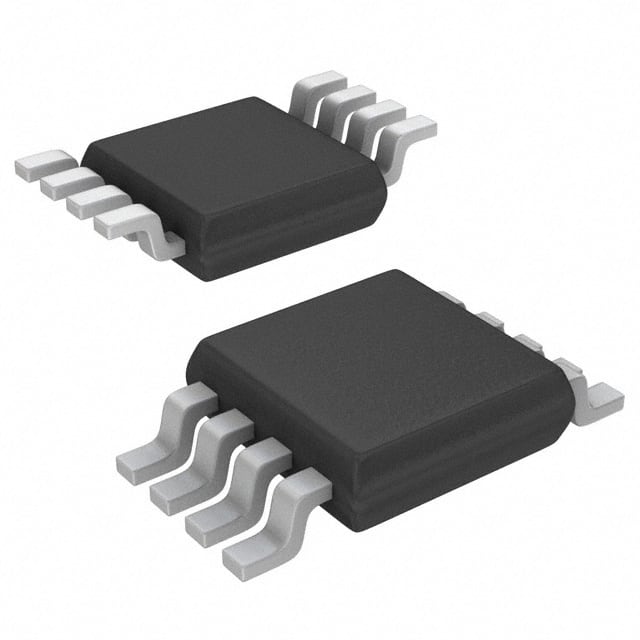Xem thông số kỹ thuật để biết chi tiết sản phẩm.

X9317ZM8T1
Product Overview
- Category: Integrated Circuit (IC)
- Use: Digital Potentiometer
- Characteristics: Non-volatile, 100 Taps, 10kΩ Resistance, Single/Dual Supply Operation
- Package: 8-Lead SOIC
- Essence: Provides digital control of resistance in electronic circuits
- Packaging/Quantity: Tape and Reel, 2500 units per reel
Specifications
- Resistance Range: 10kΩ
- Number of Taps: 100
- End-to-End Resistance Tolerance: ±20%
- Temperature Coefficient: ±300ppm/°C
- Supply Voltage Range: 2.7V to 5.5V
- Operating Temperature Range: -40°C to +85°C
- Wiper Current: 3mA maximum
- Standby Current: 1µA maximum
Detailed Pin Configuration
The X9317ZM8T1 has the following pin configuration:
- VCC: Positive supply voltage
- H: High terminal of the resistor array
- W: Wiper terminal of the resistor array
- L: Low terminal of the resistor array
- CS: Chip select input
- SCL: Serial clock input
- SDA: Serial data input/output
- GND: Ground reference
Functional Features
- Non-volatile memory: Preserves wiper position during power-off
- Increment/Decrement Control: Allows digital adjustment of resistance
- Dual Supply Operation: Can be powered by a single or dual supply voltage
- Low Power Consumption: Minimizes energy usage
- Small Form Factor: Compact size suitable for space-constrained applications
Advantages and Disadvantages
Advantages: - Non-volatile memory ensures settings are retained even when power is lost - Digital control allows precise and repeatable adjustments - Dual supply operation provides flexibility in different circuit configurations - Low power consumption extends battery life in portable devices
Disadvantages: - Limited resistance range may not be suitable for all applications - End-to-end resistance tolerance of ±20% may impact precision requirements - Temperature coefficient of ±300ppm/°C may introduce variations with temperature changes
Working Principles
The X9317ZM8T1 is a digital potentiometer that replaces traditional mechanical potentiometers. It consists of a resistor array and a wiper that can be digitally controlled to adjust the resistance. The wiper position is stored in non-volatile memory, ensuring it remains unchanged even when power is disconnected. By varying the resistance, the X9317ZM8T1 enables precise control over voltage levels, current flow, and signal attenuation in electronic circuits.
Detailed Application Field Plans
The X9317ZM8T1 finds application in various fields, including:
- Audio Equipment: Allows volume control and tone adjustment in amplifiers, mixers, and audio processors.
- Industrial Automation: Enables precise calibration and control of sensors, actuators, and motor speed.
- Automotive Electronics: Facilitates control of lighting intensity, fan speed, and temperature settings.
- Medical Devices: Provides programmable resistance for fine-tuning medical equipment parameters.
- Consumer Electronics: Used in TVs, set-top boxes, and gaming consoles for user-controlled settings.
Detailed and Complete Alternative Models
- X9C103S: 10kΩ, 100 Taps, Single Supply Operation, DIP Package
- MCP401X: 10kΩ, 256 Taps, I2C Interface, SOT-23 Package
- AD8403: 10kΩ, 256 Taps, Dual Supply Operation, SSOP Package
- MAX5481: 10kΩ, 64 Taps, SPI Interface, TQFN Package
These alternative models offer similar functionality and can be considered based on specific application requirements.
Word count: 409 words
Liệt kê 10 câu hỏi và câu trả lời thường gặp liên quan đến ứng dụng X9317ZM8T1 trong giải pháp kỹ thuật
Sure! Here are 10 common questions and answers related to the application of X9317ZM8T1 in technical solutions:
Q: What is the X9317ZM8T1? A: The X9317ZM8T1 is a digitally controlled potentiometer, also known as a digital potentiometer, which can be used in various technical applications.
Q: What is the purpose of using the X9317ZM8T1 in technical solutions? A: The X9317ZM8T1 can be used to replace traditional mechanical potentiometers, providing precise and digitally controlled resistance adjustments in electronic circuits.
Q: How does the X9317ZM8T1 work? A: The X9317ZM8T1 consists of a series of resistive elements and switches that can be controlled digitally to adjust the resistance value.
Q: What are the advantages of using the X9317ZM8T1 over traditional potentiometers? A: The X9317ZM8T1 offers benefits such as higher precision, better reliability, smaller size, and the ability to be controlled digitally.
Q: In what types of applications can the X9317ZM8T1 be used? A: The X9317ZM8T1 can be used in audio equipment, instrumentation, industrial control systems, communication devices, and other electronic circuits where precise resistance adjustments are required.
Q: How do I interface with the X9317ZM8T1 in my circuit? A: The X9317ZM8T1 can be controlled using a microcontroller or other digital control signals, allowing you to adjust the resistance value through software or external inputs.
Q: What is the resolution of the X9317ZM8T1? A: The X9317ZM8T1 has a resolution of 256 steps, meaning it can provide 256 different resistance values between its minimum and maximum limits.
Q: Can the X9317ZM8T1 be used in both analog and digital circuits? A: Yes, the X9317ZM8T1 can be used in both analog and digital circuits, as it provides a digitally controlled resistance value that can be used by other components in the circuit.
Q: What is the power supply requirement for the X9317ZM8T1? A: The X9317ZM8T1 typically operates on a power supply voltage range of 2.7V to 5.5V.
Q: Are there any specific precautions or considerations when using the X9317ZM8T1? A: It is important to ensure that the X9317ZM8T1 is operated within its specified voltage range and temperature limits. Additionally, proper decoupling and grounding techniques should be followed to minimize noise and interference in the circuit.
Please note that these questions and answers are general and may vary depending on the specific application and requirements.

